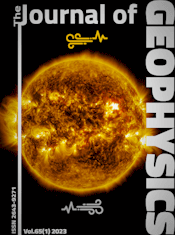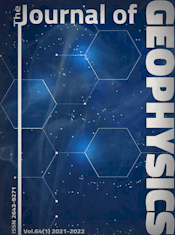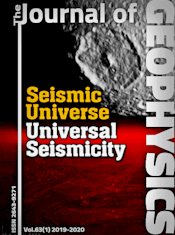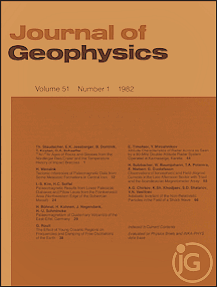Detection and mapping of Earth body resonances with continuous GPS
Article Sidebar


Vols. 1-18 (1924-1944), ISSN 0044-2801
Main Article Content
Abstract
I recently reported temporal proof that Mw5.6+ strong earthquakes occur due to (as the lithosphere rides on) vast waves of the tidally driven and gravitationally aided 1–72h long-periodic Earth body resonance (EBR). Here I report a methodologically independent spatial proof of EBR, conclusively showing that tremors are not the only earthquake type caused by mechanical resonance: observations of actual EBR waves in solid matter using continuous Global Positioning System (cGPS) and of their triggering Mw5.6+ earthquakes. Superharmonic resonance periods from the EBR’s 55’–15 days (0.303 mHz–0.7716 μHz) band are thus recoverable in spectra of International Terrestrial Reference Frame (ITRF2014) positional components solved kinematically from 30-s cGPS samplings. The signal is so pure, strong, and stable that even daylong components are constantly periodic at or above 99%-significance, with very high statistical fidelity, ϕ>>12, and ϕ<<12 characterizing overtones or undertones. cGPS stations have diurnal EBR fingerprints: unique sets of ~13–18 EBR frequencies, most clearly formed during ~Mw6+ quiescence, enabling depiction of EBR orientation for real-time EBR mapping. Furthermore, weeklong component time series reveal complete EBR and expected undertones as the signature of EBR’s companion sympathetic resonances, with very high ϕ>>12. Also, I demonstrate EBR mapping using the Mexico City–Los Angeles–San Francisco cGPS profile alongside a tectonic plate boundary, successfully depicting the preparation phase of the 2020 Puerto Rico Mw6.4–Mw6.6 earthquakes sequence. I finish by showing that the EBR triggered the 2019 Ridgecrest Mw6.4–Mw7.1 earthquakes sequence. EBR maps can now be produced for seismic prediction/forecasting and unobscuring (decoupling EBR frequencies) from geophysical observables like stress and strain. EBR engulfs the Earth’s crust, forming the resonance wind whose role and incessantness demote mantle convection from the working hypothesis of geophysics and whose applications include geophysical prospecting and detection at all scales and times. A previously unaccounted-for fundamental force of geophysics, the impulsive EBR spans the vastest energy bands, invalidating any previous claims of seismic detections of gravitational wave signals from deep space, such as by the LIGO experiment.
 ARK: https://n2t.net/ark:/88439/x073994
ARK: https://n2t.net/ark:/88439/x073994
Permalink: https://geophysicsjournal.com/article/313
Article Details
M. Omerbashich, Geophysics Online
References
Altiner, Y. (1999) Analytical surface deformation theory for detection of the Earth's crust movements. Springer-Verlag, 100pp. ISBN 9783642085109. https://doi.org/10.1007/978-3-662-03935-9
Bock, Y., Melgar, D. (2016) Physical applications of GPS geodesy: a review. Rep. Prog. Phys. 79:106801 (119pp). https://doi.org/10.1088/0034-4885/79/10/106801
Cheng, Y., Ben‐Zion, Y. (2020) Variations of earthquake properties before, during, and after the 2019 M7.1 Ridgecrest, CA, earthquake. Geophys. Res. Lett. 47:e2020GL089650. https://doi.org/10.1029/2020GL089650
Den Hartog, J. (1985) Mechanical Vibrations (4th Ed.) Dover Publications. ISBN 9780486647852
Doglioni, C., Carminati, E., Petricca, P., Riguzzi, F. (2015) Normal fault earthquakes or graviquakes. Sci. Rep. 5:12110. https://doi.org/10.1038/srep12110
Dyson, F.J. (1969) Seismic response of the Earth to a gravitational wave in the 1-Hz band. Astrophys. J. 156:529-540. https://doi.org/10.1086/149986
Ferrazzini, V., Aki, K. (1987) Slow waves trapped in a fluid‐filled infinite crack: Implication for volcanic tremor. J. Geophys. Res. 92(B9):9215–9223. https://doi.org/10.1029/JB092iB09p09215
Ficini, E., Dal Zilio, L., Doglioni, C., Gerya, T.V. (2017) Horizontal mantle flow controls subduction dynamics. Sci. Rep. 7: 7550. https://doi.org/10.1038/s41598-017-06551-y
Genrich, J.F., Bock, Y. (2006) Instantaneous geodetic positioning with 10–50 Hz GPS measurements: Noise characteristics and implications for monitoring networks. J. Geophys. Res. 111:B03403. https://doi.org/10.1029/2005JB003617
Gupta, H.K. (Ed.) (2011) Encyclopedia of Solid Earth Geophysics. Springer. ISBN 9789048187010. https://doi.org/10.1007/978-90-481-8702-7
He, X., Montillet, J.-P., Fernandes, R., Bos, M., Yu, K., Hua, X., Jiang, W. (2017) Review of current GPS methodologies for producing accurate time series and their error sources. J. Geodyn. 106:12-29. https://doi.org/10.1016/j.jog.2017.01.004
Inbal, A., Clayton, R.W., Ampuero, J.-P. (2015) Imaging widespread seismicity at midlower crustal depths beneath Long Beach, CA, with a dense seismic array: Evidence for a depth-dependent earthquake size distribution. Geophys. Res. Lett. 42:6314–6323. https://doi.org/10.1002/2015GL064942
Kinkhabwala, A. (2013) Maximum Fidelity. Max Planck Institute of Molecular Physiology report. https://doi.org/10.48550/arXiv.1301.5186
Ogawa, M. (2007) Mantle convection: A review. Fluid Dyn. Res. 40(6):379–398. https://doi.org/10.1016/j.fluiddyn.2007.09.001
Omerbashich, M. (2006a) Springtide-induced magnification of Earth mantle resonance causes tectonics and conceals universality of physics at all scales. https://arxiv.org/abs/physics/0608026
Omerbashich, M. (2006b) Gauss–Vaníček Spectral Analysis of the Sepkoski Compendium: No New Life Cycles. Comp. Sci. Eng. 8(4):26-30. https://doi.org/10.1109/MCSE.2006.68
Omerbashich, M. (2007a) Erratum due to journal error. Comp. Sci. Eng. 9(4):5-6. https://doi.org/10.1109/MCSE.2007.79; full text: https://arxiv.org/abs/math-ph/0608014
Omerbashich, M. (2007b) Magnification of mantle resonance as a cause of tectonics. Geod. Acta 20(6):369-383. https://doi.org/10.3166/ga.20.369-383
Omerbashich, M. (2020a) Earth body resonance. J. Geophys. 63:15-29. https://n2t.net/ark:/88439/x020219
Omerbashich, M. (2020b) Moon body resonance. J. Geophys. 63:30-42. https://n2t.net/ark:/88439/x034508
Omerbashich (2021) Non-marine tetrapod extinctions solve extinction periodicity mystery, Hist. Biol. 34(1):188-191. https://doi.org/10.1080/08912963.2021.1907367
Press, W.H., Teukolsky, S.A., Vetterling, W.T., Flannery, B.P. (2007) Numerical Recipes: The Art of Scientific Computing (3rd Ed.). Cambridge University Press. ISBN 9780521880688
Richter, F., McKenzie, D. (1977) Simple plate models of mantle convection. J. Geophys. 44(1):441-471. https://n2t.net/ark:/88439/y001916
Shannon, C.E. (1948) A Mathematical Theory of Communication. Bell System Tech. J. 27:379–423, 623–656. https://doi.org/10.1002/j.1538-7305.1948.tb01338.x
Simpson, J.F. (1968) Solar activity as a triggering mechanism for earthquakes. Earth Planet. Sci. Lett. 3:417–425. https://doi.org/10.1016/0012-821X(67)90071-4
Steeves, R.R. (1981). A statistical test for significance of peaks in the least squares spectrum. Collected Papers, Geodetic Survey, Dept. of Energy, Mines and Resources. Surveys and Mapping Branch, Ottawa Canada, pp. 149–166. http://www2.unb.ca/gge/Research/GRL/LSSA/Literature/Steeves1981.pdf
Taylor, J., Hamilton, S. (1972) Some tests of the Vaníček Method of spectral analysis. Astrophys. Space Sci. 17:357–367. https://doi.org/10.1007/BF00642907
Vaníček, P. (1969) Approximate Spectral Analysis by Least-Squares Fit. Astrophys. Space Sci. 4(4):387–391. https://doi.org/10.1007/BF00651344
Vaníček, P. (1971) Further Development and Properties of the Spectral Analysis by Least-Squares Fit. Astrophys. Space Sci. 12(1):10–33. https://doi.org/10.1007/BF00656134
Vincenty, T. (1975) Direct and inverse solutions of geodesics on the ellipsoid with application of nested equations. Survey Rev. 23(176):88–93. https://doi.org/10.1179/sre.1975.23.176.88
Wells, D.E., Vaníček, P., Pagiatakis, S. (1985) Least squares spectral analysis revisited. Dept. of Geodesy & Geomatics Engineering Technical Report 84, University of New Brunswick, http://www2.unb.ca/gge/Pubs/TR84.pdf
Yegorkin, A.V., Chernyshov, N.M. (1983) Peculiarities of Mantle Waves from Long-Range Profiles. J. Geophys. 54(1):30-34. https://n2t.net/ark:/88439/y090547
Young, L.E., Neilan, R.E., Bletzacker, F.R. (1985) GPS Satellite Multipath: An Experimental Investigation. Proceedings of the First International Symposium on Precise Positioning with the Global Positioning System, pp.423–432.








